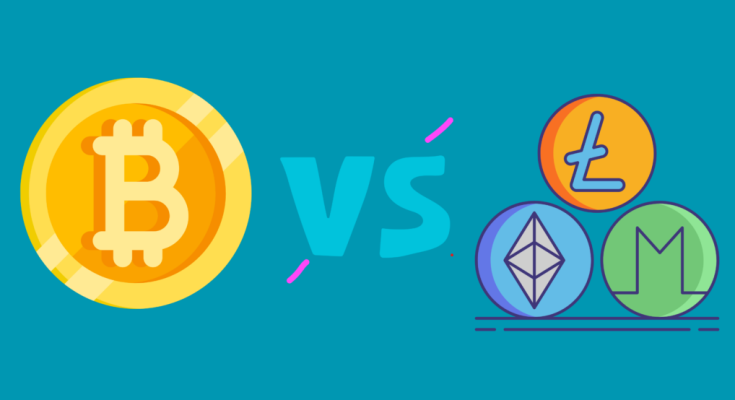The Evolution of Cryptocurrencies: From Bitcoin to Altcoins
Introduction:
Since the inception of Bitcoin in 2009 Evolution of Cryptocurrencies, the cryptocurrency landscape has undergone a remarkable evolution, witnessing the emergence of numerous alternative digital currencies, commonly referred to as “altcoins.” While Bitcoin remains the dominant force in the crypto market, the proliferation of altcoins has diversified the ecosystem, offering innovative features, use cases, and technologies. This article explores the evolution of cryptocurrencies, tracing their journey from the pioneering days of Bitcoin to the diverse array of altcoins shaping the future of finance and technology.

The Birth of Bitcoin:
Bitcoin, introduced by the pseudonymous Satoshi Nakamoto in a whitepaper titled “Bitcoin: A Peer-to-Peer Electronic Cash System,” marked the dawn of decentralized digital currencies. Bitcoin’s innovative blockchain technology enabled secure peer-to-peer transactions without the need for intermediaries, garnering attention as a groundbreaking alternative to traditional fiat currencies. Its finite supply, capped at 21 million coins, and decentralized nature appealed to proponents seeking financial sovereignty and censorship resistance.
Pioneering Innovations:
Following Bitcoin’s success, developers and enthusiasts began experimenting with alternative cryptocurrencies, known as altcoins, aiming to address perceived limitations or introduce novel features. Litecoin, launched in 2011 by Charlie Lee, offered faster transaction confirmation times and a different hashing algorithm (Scrypt) compared to Bitcoin, catering to users seeking quicker and more efficient payments. Other early altcoins, such as Namecoin and Peercoin, explored additional functionalities like domain name registration and proof-of-stake (PoS) consensus mechanisms.
The Era of Altcoin Proliferation:
As interest in cryptocurrencies surged, the proliferation of altcoins accelerated, leading to a diverse array of digital assets with varying features and use cases. Ethereum, introduced in 2015 by Vitalik Buterin, revolutionized the crypto landscape by introducing smart contracts and a programmable blockchain platform, enabling developers to build decentralized applications (DApps) and launch initial coin offerings (ICOs). Ethereum’s success sparked a wave of innovation, inspiring the creation of numerous ERC-20 tokens and fueling the rise of decentralized finance (DeFi) applications.
Diversification and Specialization:
In addition to Ethereum, a multitude of altcoins emerged, each catering to specific niches or offering unique functionalities. Ripple (XRP) aimed to facilitate cross-border payments and remittances, partnering with financial institutions and banks to streamline international transactions. Monero (XMR) prioritized privacy and anonymity, utilizing advanced cryptographic techniques to obfuscate transaction details and shield user identities. Other altcoins like Cardano (ADA), Polkadot (DOT), and Solana (SOL) focused on scalability, interoperability, and governance, addressing technical challenges faced by early cryptocurrencies.
Challenges and Opportunities:
Despite the rapid growth of altcoins, the cryptocurrency market remains highly volatile and competitive, characterized by regulatory uncertainties, security risks, and market speculation. While some altcoins have gained significant traction and market capitalization, others have faded into obscurity or succumbed to scams and fraudulent schemes. Nevertheless, the evolution of cryptocurrencies continues to present new opportunities for innovation, disruption, and financial inclusion, driving forward the adoption of blockchain technology and decentralized systems.
Conclusion:
The evolution of cryptocurrencies, from the pioneering days of Bitcoin to the diverse array of altcoins, represents a transformative journey reshaping the landscape of finance, technology, and innovation. While Bitcoin remains the flagship cryptocurrency, altcoins have introduced innovative features, use cases, and technologies, expanding the possibilities of decentralized systems and digital assets. As the cryptocurrency ecosystem continues to evolve, the future holds promise for further innovation, adoption, and integration of blockchain technology into mainstream society, ushering in a new era of decentralized finance and digital sovereignty. As the cryptocurrency ecosystem continues to evolve, the future holds promise for further innovation, adoption, and integration of blockchain technology into mainstream society, ushering in a new era of decentralized finance and digital sovereignty.
For more information related Crypto, Checkout over website Cyptogole
For more information related other topics Newsreap



